Interested in joining SAVE THE FROGS! in Peru? We don’t have any trips planned right now, but we do have an amazing trip to Ecuador happening! We look forward to frogging the Amazon with you!
Introduction | Destinations | Meet Your Ecotour Leaders |
Trip itinerary | Prepare For Your Trip | Trip Cost | Contact
Have you ever wanted to explore the Amazon rainforest, learn from experts about tropical ecology, or experience the beauty of the Andes mountains? How about all three? Well now is your chance to experience all of that and more!
We are pleased to announce the inaugural SAVE THE FROGS! Peru Ecotour, which will take place in the beautiful country of Peru from November 3rd to 15th, 2016. With such a famous attraction as Machu Picchu, as well as the Andes mountains and Amazon rainforest, you’ve surely dreamed about visiting Peru at some point in your life. Now is a fantastic time to take action and turn your dreams into reality! SAVE THE FROGS! has put together a truly unique experience in which you will enjoy searching for frogs in the Andes cloud forests and the Amazon rainforest; you will make local connections and new friends; and travel with a group of frog enthusiasts and adventurers.
We will spend the first week adventuring through the Manu Biosphere Reserve and surroundings, learning about and discovering beautiful amphibian species, conservation efforts, and scientific investigation in the Andes and Amazon. We will meet and learn from Ph.D students and Peruvian field assistants who have in-depth amphibian experience in the Peruvian cloud forest and rainforest. We can expect to find glass frogs, rain frogs, poison dart frogs, and possibly endangered species only found in these locations. Don’t be surprised if you come across a salamander hanging off a leaf or a monkey frog calling and perched on a tree trunk! Our group will have the opportunity to participate in a volunteer project at a local school; hear presentations from scientific coordinators and researchers at each biological station; swim in the Alta Madre de Dios River, and explore waterfalls, treetops, swamps, and breathtaking tropical ecosystems.
After traveling through the Manu region for eight days and staying in three remote eco-lodges we will make our way back to Cusco and then to the Sacred Valley to explore the anthropological fascinations of the area. We will acquaint ourselves with several of the most inspiring Incan ruins of the Sacred Valley – including the magnificent Machu Picchu! – each offering a unique and unforgettable experience. This chance to learn about the ecology as well as the human history of the Andes will provide you a well-rounded experience in one of the most renowned places on earth. Our group will hike through ancient trails, practice yoga in one of the spiritual centers of the world, enjoy delicious local cuisine, learn about Peruvian customs and history, and of course learn all about amphibians and ways to save them!
With so many amazing places to know and endless opportunities of collaboration, we can assure you this will be a once in a lifetime experience, so don’t miss your chance to join the inaugural SAVE THE FROGS! Peru Ecotour. There is no guarantee that we will ever run this ecotour again, so we hope you can join SAVE THE FROGS! in Peru November 3rd to 15th, 2016. Led by SAVE THE FROGS! South America Coordinator Chelsea Carson, we can assure you that your experience will be one of excitement, exploration, and growth.

More About The SAVE THE FROGS! Peru Ecotour
The SAVE THE FROGS! Peru Ecotour will take place November 3rd to 15th, 2016 and will encompass the Amazon rainforest, the Andes mountains, the cloud forests, Machu Picchu and the Sacred Valley, and an abundance of opportunities to find and photograph amphibians.

Pristimants reichlei
The SAVE THE FROGS! Peru Ecotour has been crafted to ensure an amazing, unique and thoroughly unforgettable experience that offers the best in travel, wildlife, culture and education. Peru has an incredible array of biodiversity, cultures, landscapes and ecosystems, and is home to 573 known amphibian species. That means there are lots of frogs to be found, making Peru a perfect place for a SAVE THE FROGS! Ecotour.

In addition to a wealth of amphibians you can expect to see large quantities of other fascinating wildlife such as reptiles, butterflies, rare mammals, colorful insects, and an array of birds. We hope you can join us in November 2016 for the inaugural SAVE THE FROGS! Peru Ecotour!


The Lesser Treefrog (Dendropsophus minutus) is a common frog throughout much of lowland South America and you will likely run into one during your visit to Villa Carmen Biological Reserve.
Not just a frogging tour!
While our tour will primarily be focused on everything amphibian there is so much more to expect! Throughout the thirteen day tour you can expect a little of everything:
– Hiking
– Frogging
– Mountain Climbing
– Yoga
– Spanish Lessons
– Wilderness Medicine
– Shopping at local markets
– Incan Ruin Exploration
– Swimming
– Tasting exquisite Peruvian cuisine
“Thank you for the invitation to join this wonderful sounding journey. I resisted the first time but it is so attractive, despite the distance from Australia, that I will do what I can to join you.”
Thanks”.
— Catherine E., Jannali, New South Wales, Australia

Machupicchu
DESTINATIONS
We will visit a variety of Peruvian ecosystems and stay in very pleasant ecolodges and biological stations, detailed below:
Wayqecha Cloud Forest Biological Station
The Amazon Conservation Association’s Wayqecha Cloud Forest Biological Station encompasses 1,450 acres of cloud forest and sits 3,000 meters above sea level. The station is located in the Kosñipata Valley in southeastern Peru, adjacent to the southern edge of Manu National Park. Wayqecha is situated in one of the world’s most important biodiversity hotspots, where the eastern slopes of the tropical Andes meet the Amazonian lowlands. Tremendous climatic changes occur as the landscape sweeps from snow-capped mountains to the treeless plains and dry valleys of the altiplano before a sudden descent into steep cloud forests and the broad expanse of the low-lying Amazon floodplain. This topographic complexity has resulted in an exceptional array of habitats sustaining a vast number of species.

The view from Wayqecha Biological Station, looking down the Kosnipata Valley to the Amazon Basin below.
Wayqecha has fabulous views of the Kosñipata Valley down to the Amazon Basin (when the clouds clear!). Most of the mountain valleys that connect the Andes to the Amazon have no roads and are virtually inaccessible; the Kosñipata however is one of the few catchments that have continuous forest all the way from tree line (around 3,000m) down to the Amazon basin as well as road accessibility. As such, the Kosñipata Valley is a perfect place to see how amphibian communities change with altitude, and we will be searching for amphibians all along our descent to the Amazon Basin far below.

This could be your cabin at Wayqecha!
Villa Carmen Biological Station
The Amazon Conservation Association’s Villa Carmen Biological Station is located on over 7,500 acres of land within the spectacular Manu Biosphere Reserve in southern Peru. Spanning an elevational gradient of 500 to 1,200 meters above sea level, Villa Carmen hosts an incredible array of species found in a variety of habitats, ranging from cloud forest to montane and lowland rainforest. The station and reserve support a wide variety of habitats including old-growth rainforest, lower mountain forest, secondary forests, streams, rivers, waterfalls, and a highly diverse flora and fauna. Nearby are several indigenous Wachiperi and Machiguenga communities as well as the Wachiperi Haramba Queros Conservation Concession (the first conservation concession in Peru run by an indigenous community). Dotted with sparkling streams, rivers, and waterfalls, Villa Carmen is a place to discover the beauty and bounty of nature, not to mention many species of amphibians: SAVE THE FROGS! Founder Dr. Kerry Kriger found 19 amphibian species one night at Villa Carmen!

Our cabins have amazing views of the nearby wetland, and plenty of frogs hopping nearby.
Cock of the Rock Lodge
The Cock of the Rock Lodge is adjacent to Manu National Park, and was born out of the need to protect the national bird of Peru (from where it gets its name), the fragile cloud forests it inhabits, and other native wildlife species. The lodge has a private conservation area with 12,350 acres (5,000 ha) of cloud forest from 1,100m to 2,700m above sea level. The reserve provides habitat for the Cock of the Rock, the Andean Toucan, Spectacled Bears and at least three species of monkeys. The high rainfall at this mid-elevation site means we will have ample opportunities to find frogs.

A waterfall not far from the Cock Of The Rock Lodge
Cusco
Our trip will begin and end in Cusco, which was once capital of the Inca empire, and is now renowned for its archaeological remains and Spanish colonial architecture. Set in the Peruvian Andes at an altitude of 3,400m, Cusco is the gateway to the Manu Biosphere Reserve and the Incan sites in the Urubamba (Sacred) Valley, including the world-famous ancient city of Machu Picchu. We will have ample opportunity to experience Cusco’s native Incan culture and exceptional cuisine. Machu Picchu The world famous Machu Picchu archeological site is high in the Andes Mountains (2,430m), overlooking the Urubamba River. Built by the Incas in the 15th century, Machu Picchu is world-renowned for its incredible mountains, stone structures and panoramic views. We will have the option to climb Machu Picchu mountain for a 360-degree view of the Incan ruins and surrounding valleys.

We will have the opportunity to explore the Cusco markets and see the wealth of color evident in the Andean clothing and lifestyle.
Machupicchu & Aguascalientes
Machupicchu (also known as Machu Picchu) is one of the most famous places on the planet due to the amazing Incan ruins preserved in this ancient mountaintop city and the breathtaking scenery of the surroundings. Aguascalientes is the nearest town to Machupicchu. Named for its hot springs, Aguascalientes is located on the banks of the beautiful Urabamba River, surrounded by high mountains.
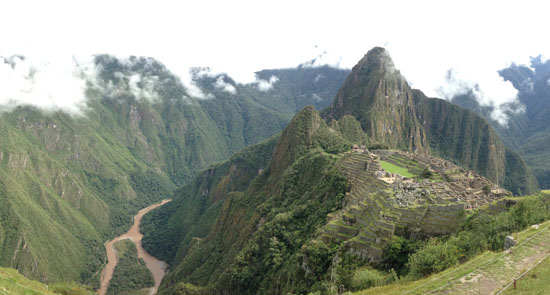
You will be very happy when you are standing right here overlooking the most famous ancient city on the planet!
Ollantaytambo
Ollantaytambo is a town in the Sacred Valley surrounded by beautiful mountains with breathtaking scenery and an abundance of Incan archeological sites. Ollantaytambo is where the Incas retreated after the Spanish took Cusco.

The Ollantaytambo archelogical site sits in the cactus-covered hills high above the town.
Pisac
The little valley of Pisac has developed as Peru’s hub of spiritual relaxation and peaceful living. There is a mix of native Peruvian and like-minded expats which call Pisac home and have created a plethora of organic eating, artisanal goods, and lively music. Pisac is home to the largest market in the sacred valley and you can be sure to find beautiful goods to take home with you. It is a very safe town with easy access to Incan ruins, farm-land, rivers and mountains, and a growing scene of spiritual retreats. Here we will stay in a quaint bed and breakfast 10 minutes walk outside of the town center and enjoy yoga, fresh local cuisine, and hiking.

A young frog enthusiast enjoying the Pisac ruins and fresh mountain air.
MEET YOUR ECOTOUR LEADERS
On top of being fun to travel with, your ecotour leaders have lots of experience in ecology, amphibian conservation, wilderness medicine, Peruvian travel, yoga instruction and an array of other skills that will ensure you the highest likelihood of having a safe, enjoyable and throughly unforgettable ecotour.
Chelsea Carson
SAVE THE FROGS! South America Coordinator
“Hello fellow SAVE THE FROGS! friends, my name is Chelsea Carson, and I am looking forward to being a Trip Leader on your SAVE THE FROGS! Peru Ecotour. I am a conservation biologist with a speciality in herpetology and community service outreach. I recently completed a Fulbright grant researching the effects of land uses on Ecuador’s amphibian populations and in 2014 spent nearly three months traveling around the beautiful country of Peru. Six weeks of that time I lived in Peru’s Sacred Valley where I completed a 200-hour Yoga Alliance certified teacher training.
Since I first visited South America in 2014 I have been in love with the ecosystems, culture, and wildlife. Originally coming to study ecology and conservation, I have focused on amphibian biology and have spent over a year and a half living in South America. With these experiences I have grown to respect and cherish the beautiful ecosystems that this continent has to offer. I have volunteered for SAVE THE FROGS! since 2013, organizing and conducting a variety of events to increase the knowledge of local issues affecting amphibians.
In June 2016 I co-led the inaugural SAVE THE FROGS! Ecuador Ecotour. For 12 days our group of 17 frog enthusiasts had an amazing time exploring the cloudforests, jungle, and mountains of Ecuador. Now I am excited to share these adventures and bring awareness efforts to Peru. I would like to share my passion for Peru and frogs and bring conservation to Manu National Park and the Sacred Valley and the SAVE THE FROGS! worldwide community. I look forward to finding frogs with you in Peru!”
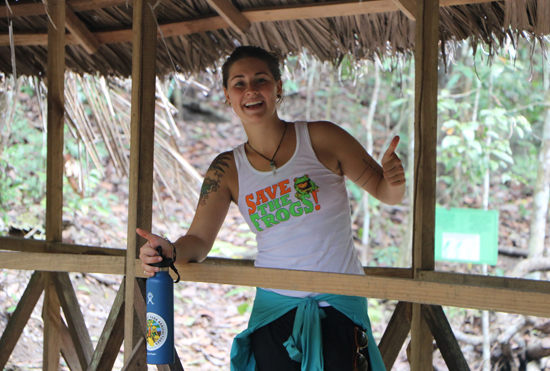
Joanna Larson
Amphibian Biologist
“Hi everyone, I am thrilled to be a co-leader on the SAVE THE FROGS! Peru Ecotour. I visited Peru for the first time at the beginning of 2016 and instantly fell in love with the country! Villa Carmen Biological Station was my first introduction to the friendly people, delicious food, and unrivaled biodiversity of Peru. In fact, I loved Villa Carmen so much that I ended up staying 2 weeks longer than I had originally planned. I am based at the University of Michigan working towards my doctoral degree. My research focuses on the evolution of diet in frogs, which means I travel around the Western Hemisphere – including a lot of time in the Peruvian Amazon – making frogs vomit using stomach flushing. This procedure doesn’t hurt the frogs, who I release to hop off and eat another meal, while I take the stomach contents back to the lab to analyze using DNA sequencing. This type of analysis gives us an unparalleled insight into what frogs eat, which can be critically important for conservation efforts. Prior to commencing my doctoral program, I surveyed the amphibian diversity in the forests of Tanzania and Gabon, where I got to work with many endemic species and even found one that is new to science! I have spent many nights at Villa Carmen searching for frogs and I am incredibly excited to be returning there this fall to continue my research and to share my love of the country and it’s amazing frogs with you!”

Kristin (Tin) Bindi
Yoga Instructor & Outdoorswoman
“I am so excited to meet all of you in Peru! I first flew into the Sacred Valley for a 200 hour yoga teacher training in 2014, where Chelsea and I first met. Since then I have been back to South and Central America several times, for an Acro (partner) Yoga teacher training and to study Ecosystems and Conservation as a part of my upper division science requirements for my college. I spent last fall studying Yoga and Sustainability in India, Uganda, and a variety of states in the USA. I attended several related conferences, interned at Vandana Shiva’s Biodiversity Center – Navdanya, and worked with teachers from the Africa Yoga Project and Jinja Community Yoga. In Uganda I taught for a women’s center, and international and local elementary school. I also spent a fair amount of my college experience focusing on Ecological Agriculture and Cultural Landscapes.
I am a true outdoorswoman with a genuine passion for bringing groups together authentically in a rich and organic way. I have been a certified Wilderness First Responder for 3 years. I spent my first two years of college studying Outdoor Leadership in central Oregon and I absolutely love facilitating group experiences! I have been a Coordinator for the Evergreen Yoga Service Collective at my college for the past two years. I have also been a Garden Educator at an urban permaculture site where I have been teaching kids about gardening, cooking, and yoga for the past two years. In September of 2016 I will be studying and teaching at an Eco Yoga Ashram outside of Pisac, Peru. I will spend October studying yogic philosophy with my gurus on the sacred rivers of the Himalayas in northern India before returning to Peru for the SAVE THE FROGS! ecotour. I am so thrilled for this gathering to learn and grow together!”

The Origins Of This Ecotour
SAVE THE FROGS! Founder Dr. Kerry Kriger developed this ecotour while traveling through Peru in February and March 2016. One night in the Amazon rainforest Dr. Kriger found 19 amphibian species, the “froggiest night of his life”, so he immediately began searching for ecolodges that are clean, comfortable and home to many frogs, and developing an ecotour that maximizes wildlife viewing opportunities in multiple ecosystems while minimizing drive times. Dr. Kriger spent seven days frogging the Peruvian Andes and the Amazon rainforest and then he spent a week in the Sacred Valley, visiting Machu Picchu and the lesser known but still breathtaking ruins of Pisac and Ollantaytambo. Dr. Kriger will not be on this ecotour, but has traveled to most of the sites we will visit and chose this route due to the wealth of spectacular scenery, wildlife and culture. Dr. Kriger met and coordinated with biologists, guides, lodge operators and bus drivers along the way who will be helping to ensure that we have an amazing ecotour.
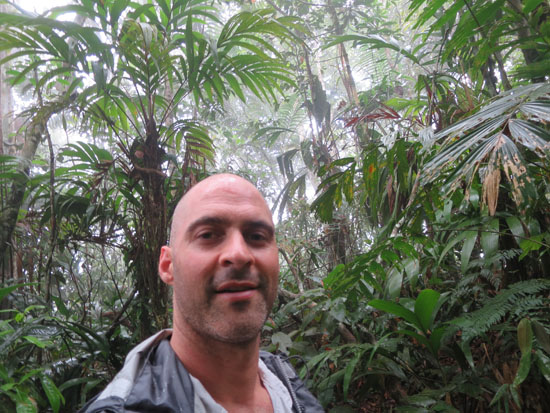
SAVE THE FROGS! Founder Dr. Kerry Kriger enjoying the lush Amazonian jungle on the mirador hike at Villa Carmen Biological Station in March 2016. You will be able to hike this beautiful trail during your ecotour!
SAVE THE FROGS! Peru Ecotour Leader Chelsea Carson lived in Peru’s Sacred Valley for six weeks and has spent over 18 months elsewhere in South America. Thus she has an in-depth knowledge of the region. Dr. Kriger and Chelsea have refined their Peruvian experiences into a perfect ecotour itinerary so as to maximize your enjoyment and delight while on your Peruvian frog adventure.

Your ecotour leader Chelsea Carson exploring the Andes mountains.
November 3rd, 2016
ARRIVAL
Our group will arrive in the famous city of Cusco, Peru and meet at 7pm to share introductions and our first Peruvian dinner, and to learn about our upcoming adventure. We will be staying at a centrally located hotel, enjoying beautiful views of the old city and eating dinner at a restaurant renowned for its gourmet local cuisine.

November 4th, 2016
CUSCO TOUR AND WAYQECHA RESERVE
After getting to know our group and enjoying the first official night together we will spend the morning getting to know the Incan city of Cusco. We will have a private walking tour of the area and you will have the chance to visit markets, search for alpaca fleece and wool garments, and wander around the town. You will have the opportunity to visit Qorikancha, which contained the Temple of the Sun and was considered the very center of the Inca world. We will meet for lunch at high noon at an amazing little restaurant called Organika, which sources its organic ingredients from small organic farms in the nearby Sacred Valley.

Qorikancha, the center of the Incan world
After lunch we will pack up our vans and head towards the cloud forest! With stops along the way to visit the scenic Ninamarca ruins and to buy fruit in Paucartambo, we will arrive at the Wayqecha Cloud Forest Biological Station in time for dinner and sunset. We will have our first opportunity to go frogging, a ten minute drive down the Manu road along a transect that is home to several montane frog species, including Oreobates gemcare, Gastrotheca nebulanastes, and Pristimantis pharangobates. We are up high in the Andes here and we will need to put on warm clothes! The cool, moist climate has been wondrous for biodiversity, as evidenced by the 200+ orchid species in the Wayqecha Reserve.

Orchids in Wayqecha
November 5th, 2016
VILLA CARMEN BIOLOGICAL STATION
Eager to get our day started we will have an early breakfast followed by a breathtaking canopy walk in a remote area of the forest. Our chances of seeing birds and arboreal mammals are high so keep a lookout in the branches! We will return to the station for presentations by Wayqecha’s scientific coordinator and administrator. After getting to know our hosts we will have a delicious lunch before we are off to the second research station: Villa Carmen, in the Amazon Basin.
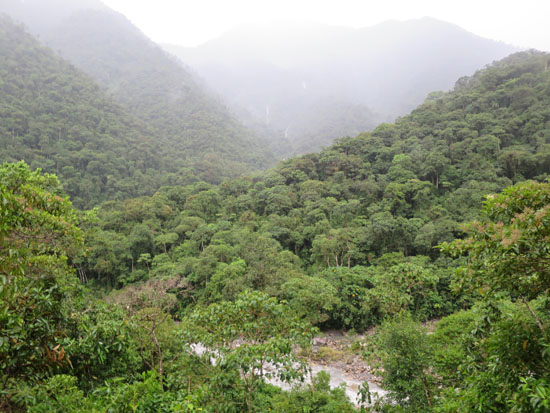
Scenery on the drive down to the Amazon
We will break-up the roughly three and a half hour drive by stopping at many of the scenic viewpoints and a beautiful waterfall in Manu National Park. Three frog species were once common at the waterfall but unfortunately haven’t been seen at the falls in years.
– Nymphargus pluvialis: last seen 1999
– Telmatobius mendelsoni: last seen 2007
– Hyloscirtus armatus: last seen 2009

We will have the opportunity to go frogging two separate times! We will search for our diurnal amphibious friends from the poison dart family Dendrobatidae. Along our descent to the Amazon, we may be able to find Oreobates granulosus, an undescribed Pristimantis species, Bolitoglossa salamanders, and beautiful toads (Rhinella margaritifera). We will arrive at Villa Carmen biological station and move into our jungle cabins set beside a beautiful wetland. Dinner will be ready for us at 8pm and then our local guide (Vanessa, the station’s scientific coordinator) will lead us frogging at the nearby aquaculture ponds.

Dendrosophus rhodopeplus
November 6th, 2016
AMAZON EXPLORATION AND DISCOVERY
An 8am breakfast at the Villa Carmen station will start our day and fuel us for the Mirador Hike at 9am, led by our local guide Leonidas, who is very knowledgeable about this section of the Amazon Basin, having spent his entire life here. This will be a spectacular hike where you can expect to learn about local flora and fauna and have the opportunity to get any of your ecological questions answered! A mirador is a viewpoint and we will have great views of the Alto Madre De Dios River in the distance, flowing downstream to meet up with the main branch of the Amazon. We will be back for lunch at 12:30pm and then spend the afternoon learning. SAVE THE FROGS! tour leader Chelsea Carson will give an amphibian conservation presentation, an introduction to the SAVE THE FROGS! organization and also a spanish lesson. Then the Villa Carmen staff and scientific research crew will tell us all about the station and its wildlife. We will have the opportunity to stretch our legs after an engaging afternoon of discussion with an outdoor yoga class at 5pm led by Chelsea. Dinner will be at 6:30pm followed by an incredible night of frogging with local researchers as our night guides!

At Villa Carmen you will have the opportunity to step inside this abandoned Russion aircraft that is being taken over by the jungle (notice the tree growing through the wings).
November 7th, 2016
BIRDS, BEACHES, AND LEARNING!
For our last full day at the Villa Carmen research station we will make sure to explore a wide variety of what the area has to offer. We will have breakfast at 7:30am in order to leave for our birding and beach hike by 8:30am. The beach is along a scenic spot at the confluence of two rivers. Upon returning from our trek, Chelsea will give a Spanish class followed by an all things frog course! This will include identification, research techniques, and conservation actions specific to Peru. Lunch will be at 12:30pm at the station. As a conservation organization we want everyone to get involved in spreading amphibian conservation and making a local and a global impact! For this we will visit a local school where we will host an amphibious activity for the kids and teach the students and teachers about ecology and environmental awareness. Returning from the school around 3pm everyone can enjoy a siesta this until our 6:30pm dinner, or choose to join a yoga class at 5pm. And of course it wouldn’t be a SAVE THE FROGS! Ecotour night without frogging! We will leave for our night hike around 7:30pm to discover the beautiful nocturnal creatures of the Villa Carmen Biological Station. We will search for Pristimantis along a stream, and monkey frogs (Phyllomedusa vaillanti) at a small jungle pond. Careful for snakes as there may be Bothrops, a venomous yet calm snake that is well-respected throughout the Amazon.
![]()
A beautiful Monkey Frog (Phyllomedusa vaillanti)
November 8th, 2016
OBSERVING WILDLIFE AND GETTING INVOLVED
To enjoy our last morning at Villa Carmen, Chelsea will offer a yoga class at 7:30am. We will eat our final Amazonian breakfast of the ecotour at 8:30am. Relaxing further into the morning our group will dive into an interactive workshop on how to get involved with SAVE THE FROGS! and as a group come up with events/activities to plan in your local communities. With a break for lunch we will continue with an outdoor class on the use of social media, storytelling, and unique outreach efforts that are effective for local and global amphibian conservation. We will be leaving Villa Carmen for our next location, the Cock of the Rock Lodge, no later than 2:30pm to ensure we arrive for a sunset showing of the Cock of the Rock lek watching. This incredible display of male sexual behavior is a beautiful portrait of avian mating techniques and makes for some unbelievable photo opportunities. With a long night of frogging ahead of us we will have a 6:15pm dinner and then head out to a variety of locations along the Manu road. At one of the locations we expect to see a beautiful glass frog species (Hyalinobatrachium bergeri), while at another we will have the opportunity to see a fun arboreal species known as Dendropsophus minutus.
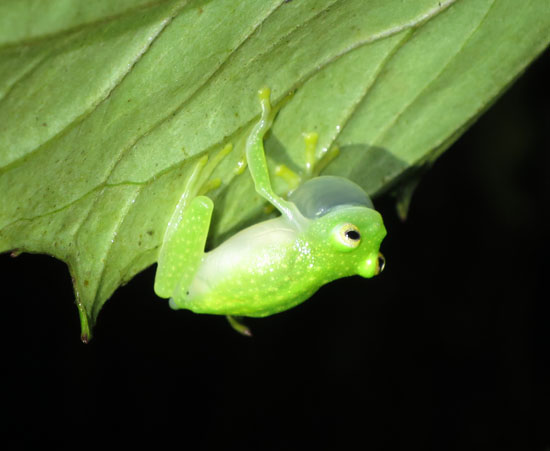
A beautiful glass frog (Hyalinobatrachium bergeri)
November 9th, 2016
FLOWERS, BIRDS, and FROGS…Oh My!
We will conclude our time at the Cock of the Rock lodge with an optional birding activity at 7am followed by breakfast at 8am and time to relax and enjoy the verdant and captivating surroundings. Our bus will leave at 11am to return to the Wayqecha Reserve. Here we will spend a tranquil afternoon walking through the orchid garden. At 6pm we will look for the Gastrotheca antoniiochoai frogs that live in bromeliads and become active just before sunset. These frogs are sometimes spotted as families or with eggs! Dinner will follow at 7pm.

November 10th, 2016
OFF TO THE SACRED VALLEY WE GO!
To conclude our time in the beautiful Manu region we will have a final hike at the Wayqecha Reserve making sure to breathe in the fresh smells of nature and listen to the singing wildlife. We will fill our bellies at the station with lunch at 1pm and leave at 2pm. While on our drive back to Cusco we will stop at the high altitude grasslands to search for Gastrotheca excubitor and Psycophrynella usurpator, two diurnal frog species that can often be heard calling from underneath moss. After about an hour of searching for our frog friends we will get back in the bus and make our way back to Cusco! After settling in at our hotel we will have a group dinner at Morena and then everyone is invited to join SAVE THE FROGS! for a complimentary drink at a locals favorite bar, El Duende, and reminisce on the beautiful week spent frogging and frolicking through the forests.

The beautiful Gastrotheca excubitor lives under the moss in the high Andes.
November 11th, 2016
CUSCO TO AGUASCALIENTES
Breakfast will be provided at our hotel and you have the opportunity to sleep in and enjoy breakfast on your own time. We will all meet in the lobby at 9:45am to leave for another school visit, organized by a SAVE THE FROGS! volunteer. We will have lunch in the city around 12pm and then load back onto our bus to head to our first stop, Ollantaytambo before catching the gorgeously scenic train at 4:30pm to Aguascalientes, also known as the Machu Picchu city! We will all meet up for dinner at 7:30pm and have a chance to walk around the town and along the banks of the very scenic Urabamba River. With Machu Picchu as our main attraction the following day we recommend you get a good night sleep to feel your best for the incredible views ahead!

Aguascalientes, the Sacred Valley and the powerful Urabamba River
November 12th, 2016
MACHU PICCHU
Wanting to take full advantage and beat the crowds we will be having breakfast at 5:45am before catching the bus from Aguascalientes up to Maccu Picchu leaving at 6:30am. You will have the option to hike one of the two mountains (Machu Picchu or Huayna Picchu), which both offer a unique perspective and a bird’s eye view of the abandoned city. We will descend the peaks by high noon and enjoy a boxed lunch. We then (at last!) will be exploring the main archeological site, where a private guide will lead us through the famous ruins of the old Incan empire. At 4pm we will catch the bus back down to Aguascalientes. There will be opportunity to wander the town or relax until we catch the evening train leaving Aguascalientes for Ollantaytambo at 6:20pm. We will be staying and dining at the Intitambo Hotel in Ollantaytambo, set between the ruins covered mountains.

SAVE THE FROGS! supporter Paige Powers on Machupicchu Mountain.
November 13th, 2016
OLLANTAYTAMBO TO PISAC
Our breakfast will be at 8am at the Intitambo Hotel and then we will visit the archeological sites of Ollantaytambo and surrounding ruins, which are a treat to see. Afterwards, we will enjoy a Pachamanca Lunch at the Albergue organic farm. The Pachamanca is a traditional Inca meal cooked upon hot rocks. We will take a tour of the organic farm and you will be able to participate in the preparation of the Pachamanca. While the food cooks, you will learn about traditional and contemporary organic farming practices. The lunch consists of a variety of local meats, or vegetarian options such as Andean sweet potatoes, house-made salads, local sauces and chicha morada (purple corn beverage). After our lunch, we will set out by bus to the little town of Pisac. Here we will be staying at the Yoga Bed and Breakfast (where Chelsea did her yoga teaching training in 2014) known as Nidra Wasi. Chelsea will lead those interested through a yoga class at 5pm in the hotel’s yoga studio. Dinner will follow at 6:30pm at the Nidra Wasi organic restaurant, Sweet OM. That night we will all gather for a quick look at the stars and an amphibian class!

Ruins set high on the side of the mountain in Ollantaytambo
November 14th, 2016
RUINS, LLAMAS & ALPACAS
What a beautiful day we will have enjoying the town of Pisac, known for its artisan market, Incan ruins, and organic cuisine! After breakfast at 8am at Sweet OM we will hike to the Pisac ruins at 9am, set on top of a mountain, and have our last chance to feel the lingering spirit of the once great Incan Empire. With the morning free to hang out at the upper ruins or hike down the mountain to see another site we will meet at 12pm for lunch in town. At 1pm we will load up our bus and head towards Cusco…but not before stopping at the Awah Kancha Llama Farm! Here you will have the chance to tour the farm and learn about llamas, alpacas and other unique creatures native to the Andes mountains. Our bus will leave around 3pm and head back for the short drive to Cusco. The afternoon will be free for you to explore Cusco, local museums, and buy any last souvenirs to celebrate our time together. We will have a nice dinner in Cusco to commemorate our wonderful adventure and the first ever SAVE THE FROGS! Peru Ecotour.

You will definitely meet some llamas and alpacas in the Sacred Valley!
November 15th, 2016
FINAL GOODBYE
We will enjoy breakfast at our hotel and say our final goodbyes of the trip: the inaugural SAVE THE FROGS! Peru Ecotour has officially come to an end! Chelsea will help you arrange transportation to the Cusco airport. Buen viaje!

Rocks above Cusco
PREPARE FOR YOUR TRIP
Traveling in Peru may be a different experience than what you are accustomed to, so we have written a few things we would love to pass along!
Physical Fitness
Most of our hikes will be easy to moderate. Expect guided hikes to last 2-3 hours. We will travel slowly on the trails so that we will have a better chance of viewing wildlife. It is important to know that the trails may be slippery and muddy, so having good footing and closed-toes shoes are essential! Adventurous explorers will have the option to take more strenuous hikes. While we do have scheduled activities planned for you, there will be times where you will have the choice of how to spend your time. Would you prefer to go on a morning jungle hike or bird watch from a hammock on your balcony? The choice is yours! Wear sunblock and stay hydrated Manu National Park and the Sacred Valley are located at high altitudes and close to the equator. While this is exciting, it comes with a few cautions: in particular, the sun is strong and the air is thin! Make sure to hydrate, wear sun protection, and get plenty of rest.

Hypsiboas geographicus
Altitude
The highest you will have to be on this ecotour is in Cusco, which is at 3,400m (11,154ft). You will want to take it slow your first couple days in Peru as we will be in the Andes and your body needs to acclimatize. However, we have designed this ecotour to minimize any altitude discomfort so we do not expect there to be any issues even for people who live at sea level. We will arrive in Cusco (3,400m, 11,154ft) and immediately travel to Wayqecha (only slightly lower at 3,000m), before descending to the Amazon Basin. Then we will return to Cusco to prepare for the Sacred Valley portion of our ecotour. During this time we will be staying in Machu Picchu (2,400m, 7,874ft), Ollantaytambo (2,792m, 9,160ft) and Pisac (2,900m, 9,514ft). As some of our locations will be at high altitudes, stay aware of how you feel and stick within your comfort level while hiking and participating in active adventures. You will always be able to opt out of a hike and just chill out looking at the surrounding mountains! Chelsea is a certified Wilderness First Responder and will have resources and advice if you feel any of the effects of altitude sickness – and most hotels in Cusco have oxygen tanks — not becuase they expect you to need them, but they are prepared in case you do.

Planning to explore Peru before or after the Ecotour?
There is plenty to do in Peru so if you have extra time to enjoy the country, we are happy to advise you on hotel lodging and recommended locations. Please contact Chelsea Carson with your possible schedule if you seek travel advice: chelsea@savethefrogs.com

Our group will be eating lunch here in Ollantaytambo after we take a tour of an organic garden and get a class on how to cook Peruvian cuisine.
Currency
Peruvian currency is called the Nuevo Sol. It currently has an exchange rate of about US$1 equals $3.2 ~ $3.3 soles. It is wise to have cash and a major credit card or two on you, lest you want or need to purchase something not included in the Ecotour. There are currency exchange companies in Cusco or withdrawing from an ATM is a good option as well.

Crime Prevention
While we will be traveling in a group and the risk of experiencing crime is low, please be aware that Peru, specifically within the cities, has had issues with crime. Usually it is petty theft, but it is commonly aimed at tourists so take safety measures when walking about. We recommend leaving all valuable items in a safe at the hotel and only carrying what you need. A money belt inside your clothing and/or an over the shoulders bag (not an easily snatched purse) is also a good option for carrying necessary items.
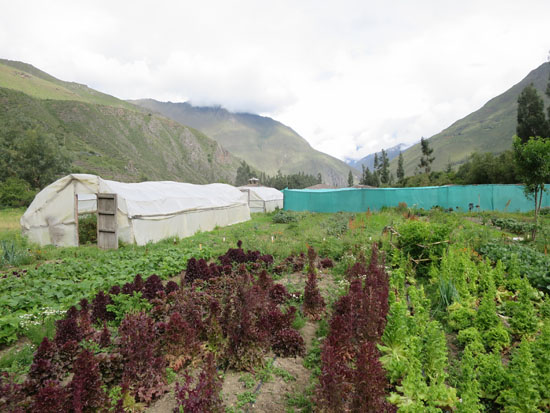
We will take a tour of this organic garden while in the Sacred Valley…and then eat a lunch made from freshly picked produce!
Visa requirements
No visa is required for citizens of the United States. If you are not a United States citizen, then please check your country’s laws about traveling to Peru.

There’s nothing like the taste of fresh jungle water! SAVE THE FROGS! Founder Dr. Kerry Kriger got to drink straight from the bamboo when he visited Villa Carmen in March 2016.
Passport requirements
Your passport must be valid for at least six months past the date you plan to depart Peru or you will not be allowed into the country. So please ensure your passport does not expire within six months of your departure date!
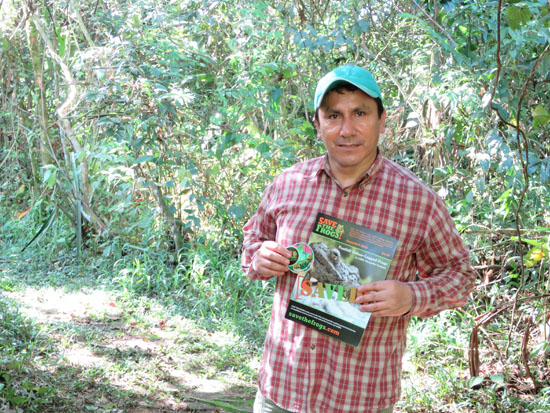
Villa Carmen’s Station Manager David Guevara Segovia looks forward to giving you a tour of the biological station.
Dietary preferences
The SAVE THE FROGS! Ecotour to Peru can accommodate most dietary preferences and/or requirements, including vegan and vegetarian. We will sample an array of Peruvian culinary delights. Please inform us in advance of any dietary needs, in as much detail as possible. When possible please also take into account that you will be traveling in a foreign country somewhat unaccustomed to certain dietary restrictions, so although we will do our best to accommodate everyone please be flexible if it allows.

Villa Carmen’s Scientific Coordinator Vanessa and local guide Leonidas examine some Amazonian plant life along the Mirador Hike.
Water and Food
While Cusco has decent water filtration we recommend not risking drinking the tap water during your time here. This also goes for the street food, and make sure to watch out for juices, unpeeled fruit, uncooked vegetables etc that may have been washed in the water. Most of the lodges and hotels we stay at will have large jugs of drinkable water and are used to catering to tourists. We do recommend traveling with some type of filtration device (e.g. PUR filters or Steripen UV light) unless you are the type of person who likes buying plastic bottles of water!
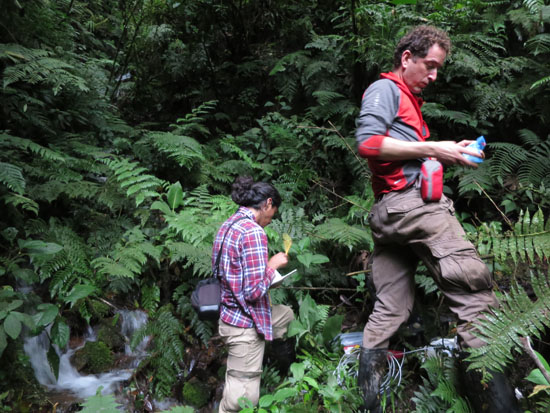
Alex Ttito and Dr. Alessandro Catenazzi searching for frogs in the Peruvian cloud forest. Dr. Catenazzi has been researching amphibians here for twenty years. He has taken both STF! Founder Dr. Kerry Kriger and STF! Board Member Dr. Sarah Kupferberg frogging at Wayqecha and Villa Carmen. You will be visiting some of his favorite frog spots!
Vaccinations & Medication
Check the Center for Disease Control’s Peru webpage for specific information about what vaccinations or medications you may need, and ask your doctor. All participants should be up-to-date with all routine vaccinations before traveling abroad. Malaria is present within Peru but is not a huge threat. However if you would like to get malaria medicine please follow your doctor’s instructions. You will not easily be able to find malaria medication once in Peru.

View from the train we will take, somewhere between Ollantaytambo and Aguascalientes
Patience
Latin American time is slower than US time! While we have worked very hard to avoid any delays or alterations in the schedule, in Latin America sometimes there are delays and changes. This only means to remain patient and remember to just enjoy your surroundings! We are going to be in some of the most amazing tropical ecosystems in the world, so if any changes in timing happens, rest assured the scenery will be worth it.

The Urabamba River flowing past Aguascalientes.
Alcohol
Looking for frogs at night is not the world’s safest activity. As such, drinking and frogging really don’t mix. We request that you not get anywhere remotely close to drunk prior to frogging. If you do feel the need for a dinnertime alcoholic beverage, we strongly suggest limiting it to one drink. Post-frogging, feel free to let loose at the bar.

Hypsiboas lanciformis
Professional Development for Students and Teachers
Teachers seeking to fulfill professional development or continuing education requirements may be able to claim this trip as a tax-deduction (ask your tax professional for details). Please let us know if you have any questions. Students seeking to receive university credit may be able to acquire credit through your university’s internship program; if you are interested in this option, please contact us. Students wishing to receive SAVE THE FROGS! Academy credit as part of this expedition should also contact us.
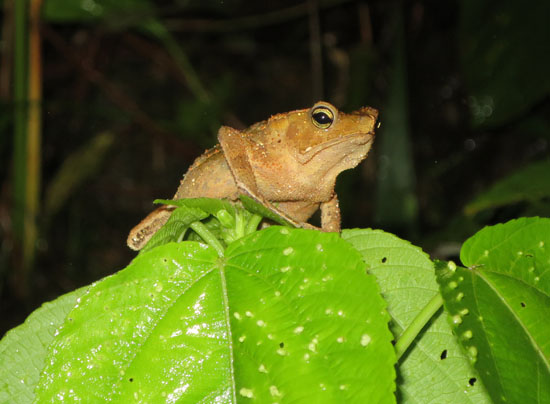
Rhinella margaritifera
What To Bring
This list will help your trip planning (we will send you a more detailed version once you confirm your participation):
• Field Clothes
• Headlamp
• Swim suit
• Walking shoes
• A rain jacket and rain pants
• Warm layers (Cusco and Wayqecha are cold at night as you can see on this weather page!)
• A water bottle
• Camera
• A notebook and pen
• Comfortable clothes for travel and yoga
• A nice outfit for dinner in Cusco
• A smile and willingness for adventure!
“I am looking forward to having the opportunity to learn, explore and hopefully make a positive impact for our friends, the frogs.” — Sara Tyson, Sacramento, CA

Hypsiboas geographicus
TRIP COST
The 2016 SAVE THE FROGS! Peru Ecotour pricing is as follows:
– Ecotour for one person: $2,595
– Ecotour for a party of two: $4,995
– Ecotour for a group of three: $7,295
– Full-time students save an additional $100 each.
– Payment plans are available.
– All participants must be active SAVE THE FROGS! Members (join here).
Included with your ecotour payment is all lodging, in-country transportation, world-class tour guides and their scientific expertise, park entrance fees, tips, and all meals. You are required to cover your costs of airfare, snacks, alcoholic beverages, souvenirs, and possibly a departure tax when you leave the country. Note again that you will be required to pay your own airfare to Peru (estimated at $750 roundtrip from the USA).
To secure your space on the ecotour you will need to send us a $1,000 per person non-refundable deposit via check or credit card. Full payment is due by October 3rd, 2016. Failure to pay in full by October 3rd, 2016 may result in forfeiture of your deposit money and your space on the eco-tour.
All proceeds support SAVE THE FROGS! worldwide amphibian conservation efforts, enabling us to protect amphibians and promote a society that respects and appreciates wildlife and nature. A portion of these proceeds will go directly to our ongoing South American conservation efforts.
Register for the SAVE THE FROGS! Peru Eco-Tour
If you are interested in this trip, please email Chelsea Carson at chelsea@savethefrogs.com so we can get you registered for this amazing adventure!
The waiver you will sign
In order to take part on this trip, you will be required to sign a waiver acknowledging the inherent risks of ecotourism in Peru, and legally releasing SAVE THE FROGS! and affiliated trip operators and personnel from legal damages and consequences. Please do not apply unless you understand this and the implications. That being said, we strive for a safe trip!

Bolitoglossa salamander
Cancellations and Refunds
You must notify us directly if you need to cancel your trip. If you need to cancel your trip, contact Chelsea Carson at: chelsea@savethefrogs.com
— If you cancel before October 3rd your entire trip will be refunded, minus your deposit (as deposits are non-refundable).
— If you cancel after October 3rd, you forfeit your entire trip fee.
SAVE THE FROGS! regrets that it cannot make exceptions to the reservation and cancellation policy for any reason, including personal emergencies. The reservation and cancellation policy applies to all reservations. You may want to consider purchasing travel insurance from a third party, so that if an issue arises (such as health or family concerns or airline issues), then your travel insurance could likely provide you compensation.

Nymphargus pluvialis egg mass
More about Peru & the Ecotour
We will pack in the adventure while in Peru, covering a few of the most unique ecosystems the country has to offer. Including an extended stay in the Manu Biosphere, starting high in the Andes where the clash of forest meets alpine ecosystems and traveling east into the Amazonian lowlands. We then will spend the final 5 days of our trip exploring the famous Sacred Valley, known for its rich culture, breathtaking Andean highlands, and other-worldly Incan ruins. Peru is an array of cultures, places, and wildlife with a vast amount of species and ecosystems, with the Manu region housing the highest biodiversity of amphibians and reptiles in the country.
From the Andes to the Amazon we will get deep into the local traditions, riveting history, and conservation going on! SAVE THE FROGS! has chosen to do an ecotour in Peru to not only explore the amphibians but also to engage in the environmental and social richness. Through ecotourism we hope to promote sustainable travel and ignite a passion for involvement in local frog conservation efforts.

More than just an ecotour
We will get to indulge in many activities, there is sure to be lots of frog filled excitement through each place while learning about ecosystem dynamics, conservation, and courses on yoga, Spanish, and local spirituality. With a group of SAVE THE FROGS! participants and your tour leader Chelsea Carson there is sure to be lots of smiles, laughs, and learning going around.
While frogs will certainly be the focus of our SAVE THE FROGS! Ecotour, we will have opportunities for:
– Amazon jungle experiences
– Yoga
– Wilderness medicine classes
– Interactive Conservation efforts
– Spanish lessons
We hope to see you in November 2016 for this once in a lifetime experience!
Group Size
For the Manu segment of the ecotour, our group will consist of a total of 12 participants and two SAVE THE FROGS! Tour Leaders, making for a grand total of 14. For the Macchupichhu segment of the trip, we will have a total group size of 16.
Arriving in Peru
The ecotour begins in Cusco, Peru the evening November 3rd, 2016 at 6pm. We recommend arriving in Cusco anytime on November 3rd. We stay in Cusco that night and don’t leave until after lunch the next day so if your plane is late you should still be fine. If you plan to arrive early, please ask Chelsea for suggestions on lodging and things to do.
Speaking Spanish
Trip Leader Chelsea Carson speaks Spanish and thus you will be fine without thorough Spanish knowledge. That being said you will likely be able to connect with local people more easily if you speak Spanish. We will offer some Spanish lessons during the Ecotour and encourage you to ask us how to say words or phrases you want to know. In this day and age there is a wealth of free language learning materials online, so regardless of how old you are or how competent with acquiring new languages you think you are, you CAN learn Spanish. Three great iPhone apps for learning Spanish are iTranslate, DuoLingo and iTranslate Voice.
Peru: a perfect place for a SAVE THE FROGS! Ecotour
With so many amphibians and such a depth of culture, Peru is a perfect place for SAVE THE FROGS! conservation and ecotour activities. We will be sharing our amphibian knowledge and passion to the local ecosystems and people and we cannot wait to have you join us on the tour. We look forward to seeing you in Peru November 2016!

Feel free to add this flyer to your site to help spread the word. Please link to https://savethefrogs.com/peru2016
Thank you!
Contact
Please email Chelsea Carson (chelsea@savethefrogs.com) or Dr. Kerry Kriger (kerry@savethefrogs.com) with any questions and to inform of us of your interest in joining us in Peru.
WE HOPE TO SEE YOU IN PERU!

We may see Bolitoglossa salamanders!


